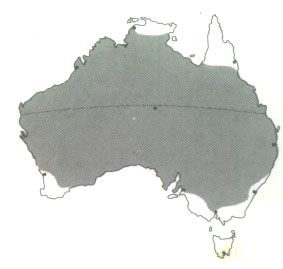![]()
 |
 |
DISTRIBUTION: Very common except in wet coastal forests. Ranges to Lesser Sunda Islands. |
Pair of Zebra Finches. Male is on the left. |
Distribution Map |
|
IDENTIFICATION. LENGTH = 100 mm MALE: Head grey with pale chestnut on ear-coverts. Back grey-brown; rump white; tail-coverts barred black and white. Face white, bordered with black; throat, neck and upper breast pale grey with fine black bars; lower breast black; flanks pale chestnut with white spots; belly and undertail-coverts white. Eye and bill red; legs red-orange. FEMALE: Similar to male but lacks ear patches and flank marks; throat and breast pale buff; underparts pale buff; bill paler. IMMATURES: Similar to female; bill black; legs grey; eye grey-brown.
|
NESTING. Breeds in most months, depending on seasonal conditions. Nest flask-shaped with spherical nest chamber 120-200 mm in diameter, a side entrance 30-80 mm in diameter and an entrance tunnel , 50-250 mm long. Made of grass stems, large on outside, getting progressively smaller towards inside; built on twigs of bushes and low trees, occasionally in hollows or on the ground. Eggs: usually four or five; pure white; 11 X15 mm.
|
|
FORMS.
|
|
AVIARY BREEDING. NESTING TYPES: I have found that these birds will nest almost anywhere although they will usually prefer a nest box including parrot nest boxes rather than build a nest of their own. I have seen these birds build nests in tea tree branches and planted trees but very rarely. Best results have been from boxes 150 mm square X 125 mm high with a 40 mm access hole in the front and a small landing platform just below the entrance. (See the Plans page for more information) FEEDING: A general finch mix is ideal for this bird. Birds will also readily take seeding grasses and live food. However I have had seen these birds breed successfully with just a mixed seed diet. Egg and biscuit will also be taken readily. OTHER FEEDS: Cuttlebone and shell grit should be supplied at all times. SPECIAL REQUIREMENTS: There are no special requirements for this species. However care should be taken not to house this species with the Masked Finch or the Long-tailed Finch or any of the subspecies.
|
| AVIARY SPECIFICATIONS. | WIRE MESH: 1/4 x 1/4 or 6 mm x 6 mm | Also known as mouse wire |
| LENGTH: 11ft 6in or 3575 mm | WIDTH:6ft or 1800 mm | HEIGHT: 8ft or 2400 mm |
| SHED: Half the aviary should be enclosed.
These are recommendations only and individual breeders may have different dimensions and specifications.
|
FLOOR: I have found a dirt floor preferable. |
OTHER: |
|
BREEDER SUBMISSIONS. |
|
| From |
![]()
Author
P Campbell
Copyright © 2002 P. Campbell. All rights reserved.
Revised: April 23, 2002
.